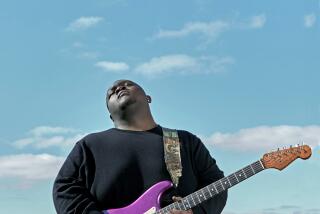Kessel Proves He’s Still Top Jazz Guitarist
- Share via
Guitarist Barney Kessel is not too impressed with jazz’s brat pack. Informed that 24-year-old guitar wiz Mark Whitfield turned in sizzling performances last Thursday and Friday nights at Elario’s, Kessel nodded thoughtfully. Then he asked a simple question: if you put the needle down on Whitfield’s album (Kessel hasn’t quite transitioned to laser-operated CDs), could you tell it’s him? Does he have his own voice?
As if to demonstrate, Kessel took the stage at Elario’s Saturday night and during two sets spanning more than three hours of music, delivered a musical sermon on the state of the jazz guitar.
At 67, Kessel seems supremely confident in his phenomenal abilities. With nothing to prove after more than 50 years of fretwork, Kessel draws tastefully from his deep musical tool bag. He doesn’t have to heft a bigger hammer just to get attention.
The Kessel style is a complex equation involving infinite combinations of three basic elements: swinging, single-note melodic lines, a la Charlie Christian; orchestral treatments of melodies within a dense context of shifting chords and bass lines, all supplied by Kessel; and all-out speed runs that mash a dizzying number of notes together into dense, bright clusters.
In Kessel’s hands, potentially worn-out standards such as “Loverman,” “April in Paris” and “Summertime” are made new. Rock and popular hits like Lennon and McCartney’s “Yesterday” are exploded and reassembled, as a Cubist painter might approach a traditional still-life. Even songs Kessel has been doing for years, such as “Jelly Beans,” are fresh, because Kessel never plays them the same way twice.
Kessel was backed by bassist Bob Maize, who played on Kessel’s 10-year-old “Jelly Beans” album, and drummer Tootie Heath, who had never worked with the guitarist before. Maize was slow to merge with the telegraphic rapport established early on between Kessel and Heath. But by evening’s end, this jazz machine fell into a well-oiled groove.
Kessel makes everything he does look easy. The fingers of his left hand flutter lightly over the strings. It doesn’t appear that they are moving fast enough to throw off the amazing rainbows of sound that emerge. His right hand alternates between flat-picking and finger-style, with his thumb supplying bass lines while three fingers find chords and melodies.
Between songs, Kessel often takes time out to exercise his deadpan, Oklahoma-bred sense of humor.
He told the audience about a 1930s Big Band leader who turned off audiences with stolid demeanor--until a “lip tuck” operation suggested by his manager forced his mouth into a permanent smile, and his career ascended.
And Kessel encouraged listeners to applaud--even if they didn’t appreciate the music.
“It will improve the efficacy of your circulatory system,” he claimed.
Kessel hasn’t released a new album since the 1988 “Red Hot and Blues.” Let’s hope he lands a deal soon, because he is still one of jazz’s reigning guitar kings. Youngsters such as Whitfield--a strong player in his own right, but searching for an original musical voice--could learn a thing or two from this seasoned master.
A final word, or three, about the atmosphere at Elario’s: hot, smoky and distracting.
Recommendations: open some windows or fix the air conditioning; ban smoking, at the very least in the front rows, where one idiot sailed clouds directly over the bandstand; and demand, both on menus and in pre-show announcements, that the audience refrain from loud talking during sets.
Kessel returns to Elario’s this Thursday and Friday nights, replacing guitarist Grant Geissman, whose shows were canceled.
More to Read
The biggest entertainment stories
Get our big stories about Hollywood, film, television, music, arts, culture and more right in your inbox as soon as they publish.
You may occasionally receive promotional content from the Los Angeles Times.








